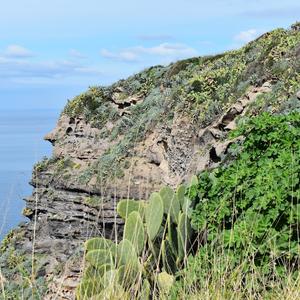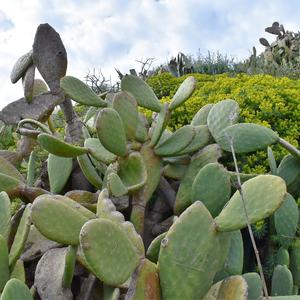28 July 2021
The Indian fig, native from Mexico, is currently one of the most invasive plants in Europe, where it was introduced first for collecting and then because of the edible and tasty fruit.
The plant is a spiny cactus that lives around 80 years and may grow up to 5-7 m. Flat obovate segments (cladodes), 20-60 cm long and 10-40 cm wide, make the stem. Basal cladodes become woody with age and form a large trunk that supports arborescent individuals. Cladodes photosynthesize and bear several circular areoles capable of developing new shoots, flowers, or spines. True spines, which may even lack, are white and 1-2.5 cm long. Glochids, instead, are tiny, spiny hairs that grow in tuffs and have backwards pulling barbs. They easily detach from the plant, lodge in the skin and are very difficult to remove. Flowers form at the apex of the cladodes and are yellow or orange. The fleshy fruit varies its colour with ripening and variety, from pale green to orange, and bears several seeds. Reproduction is both sexual and vegetative. Even a small section of a cladode can root and grow when a minimum of two areoles are present.
Opuntia ficus-indica has been largely employed by man in its area of origin from ancient times and nowadays is cultivated in many areas worldwide, most for the fruits (rich in vitamin C) but also for the rearing of cochineal insects (to be processed for the dye they contain) or, in the case of thornless forms, as an excellent supplementary livestock forage. Italy is the third country in the world for prickly pears production and the first in Europe. Most of the cultivated areas are in Sicily, whose prickly pear fruits are often acknowledged as traditional or PDO (protected denomination of origin) specialties.Abandoned agricultural land and disturbed shrub land are ideal for O. ficus-indica invasion. The species is difficult to eradicate because of the efficient seed dispersal by animals and the rapid vegetative propagations. Biological control has proved effective in some areas, but it conflicts with commercial production.
In the Ponziane islands, O. ficus-indica is widespread in Ponza, Ventotene and Santo Stefano, and may threaten the conservation of habitats of Community interest (under the Habitats Directive 92/43/EEC) such as the maquis with Euphorbia dendroides (5330), the coastal communities with Helichrysum litoreum and Artemisia arborescens (5320) and the sea cliff vegetation with endemic Limonium (1240). In Ventotene, Opuntia ficus-indica is abundant and with large individuals at Punta dell’Arco, where it is a residual from the wind breaking barriers used to protect cultivations. In Ponza, the young cladodes are used to prepare a special “parmigiana”.

